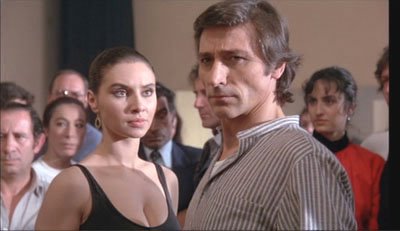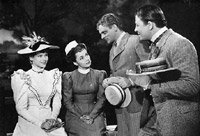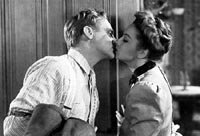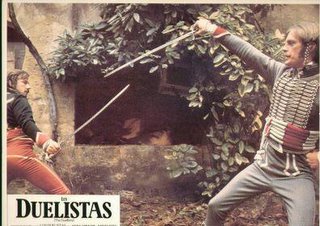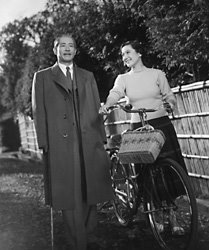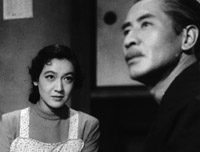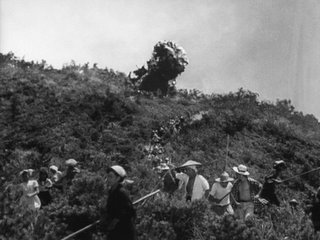If.... (1968)

Director: Lindsay Anderson
Where would English creatives be without their public schools? So many books and films have come down to us over the years telling us what a rotten life it is for boys in English boarding schools that I have to wonder why the government hasn't shut them all down as an act of mercy. Of course, without the strife of a public school education, the monied classes in England would have precious little to gripe about. So here we are, watching Lindsay Anderson (via his stand-in, Malcolm McDowell) cry into his G&T over his mistreatment at the hands of older boys, dotty instructors, and a corrupt, self-important headmaster, and fantasize his revenge.
Mick Travis (McDowell) is one of three sixth-formers who form a small rebel faction at the fictional College House (played, in part, by Anderson's real alma mater Cheltenham). Travis hangs Life magazine photos of African freedom fighters in their hideaway and listens to African music. Beyond this and hair the upperclassmen think is too long, it's hard to see what harm Travis and his mates are doing. Nonetheless, they are identified as subversives and caned savagely for the good of the school. The militarily disciplined members of College House seem too dense to realize that physical punishment only serves to radicalize these normally rebellious teens beyond reason. What transpires in the way of their revenge reflects the student revolts all over the globe in 1968, the year this film was released.
From the vantage point of 2006, the experimental devices used in If.... seem hopelessly outdated. Mick meets a girl in a cafe after he has stolen a motorcyle and appears to have a sexual encounter with her, after which she, fully clothed, serves coffee to his friend. This undoubted fantasy appears real because of the abrupt cutting so fashionable at the time. She pops up frequently after that in situations where she could only be a fantasy, but the film does not want to acknowledge that she is not really there. What does she symbolize? Damned if I know. Maybe Patty Hearst saw this film and gained some inspiration for her radical slumming, um, I mean, Stockholm Syndrome programming.
Malcolm McDowell emerges as a genuinely scary rebel, and it is easy to see why Stanley Kubrick cast him in the far superior A Clockwork Orange after this breakout performance. However, he never really seemed to be a boy in If...., and that is the one element that would have given this film more poignancy. The younger boys at College House were, in fact, tyrannized and terrorized by their elders. I thought much would be made of the new boy, Jude, when the film introduced him at the beginning. In fact, he disappears into the woodwork when Travis comes on the scene, leaving me confused about what Anderson wanted to accomplish.
The film was shot in color and black and white. There is a story afloat that budgetary constraints caused Anderson to mix stock. This appears not to be true. Lighting problems within the school caused an absence of color in the color stock, and Anderson liked the effect. I don't know whether I think he used the contrast as well as he could have, but as an experiment, I think he did pretty well with it. It certainly catches one's attention, though this well-paced film didn't really need that kind of help.
If.... spoke to an entire generation of fed-up youth, and for that alone it is worth examining. Now, so many years distant from the generation that eschewed being fodder for the military-industrial complex, it seems slightly quaint. Yet, I can imagine a new generation finding this movie and embracing its rebelliousness. War is still with us, and young people are still expected to sacrifice for principles they have been conditioned to uphold. A few restless minds just might find their way to a rooftop and turn on their own kind. At least, I hope so. l

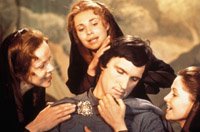





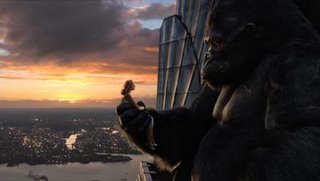



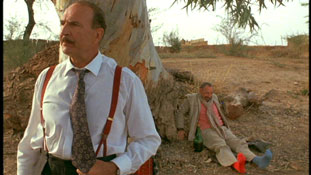



 USA Today captioned this photo: "With an impromptu smooch, a sex symbol was born at the 75th Academy Awards." I think we can assume that the newly born sex symbol was NOT Halle Berry.
USA Today captioned this photo: "With an impromptu smooch, a sex symbol was born at the 75th Academy Awards." I think we can assume that the newly born sex symbol was NOT Halle Berry.


